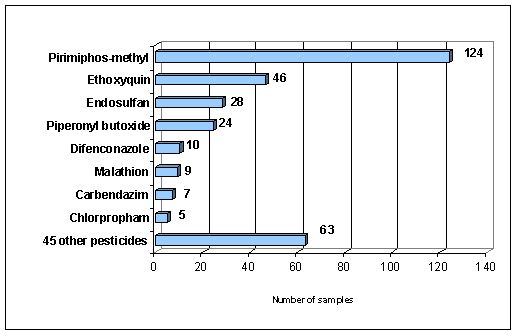Feed samples analysed by the Institute of Food Safety, Netherlands
In the Netherlands the Food and Consumer Product Safety Authority (VWA) is the competent authority for the official control of feed. As part of this control, feed samples are taken at feed producers and at border control. The animal feed samples were collected from 2006-2009, and the samples were analysed by RIKILT, Institute of Food Safety, by a multi-residue method for pesticide residues.
In the four-year period, the RIKILT institute analysed 840 samples. The type of feed samples analysed covered a large variety of animal feed ranging from cereals, grains and seeds, to more complex mixtures of compound feed along with by-products from the food industry. The type of feeding stuff analysed also covered the four most important livestock species, pig, beef cattle, dairy cattle and hens (see Table 3-3 in section 3.2 Consumption of feed). The type and number of feed samples are listed in Table 3 9.
A total of 272 (32%) of the 840 samples analysed had detectable residues. The percentage of samples with detectable residues varied a great deal depending on the type of food. The highest percentage of residues was found in milk products (100%), compound feeding stuffs (80%), milk substitutes (65%), and by-products of the food industry (61%). So far no MRL for animal feed has been defined, except for feed that is also used as food, e.g. cereals.
The frequency of the eight most frequently found pesticides is shown in Figure 3.4. A total of 53 different pesticides were found. Pirimiphos-methyl and ethoxyquin were the pesticides most frequently found and were detected in 124 (15%) and 46 (6%) samples, respectively, out of the 840 samples analysed. The highest concentration of a pesticide residue was 211 mg/kg of ethoxyquin in salmon oil analysed in 2006.
A large part of the most frequently found pesticides are only found in very few commodities.
| Type of feed | Number of samples analysed | Samples with detectable residues | % |
|---|---|---|---|
| Compound feedingstuff | 95 | 76 | 80 |
| Byproduct of foodindustry | 62 | 38 | 61 |
| Cereal grains, their products and by-products | 96 | 41 | 43 |
| Fat/oil vegetable and animal mixed | 6 | 1 | 17 |
| Fish, other marine animals, and by-products (fat/oil) | 10 | 5 | 50 |
| Forages and roughage | 89 | 2 | 2 |
| Land animal products (fat/oil) | 72 | 1 | 1 |
| Milk products | 2 | 2 | 100 |
| Oil seeds, oil fruits, their products and by-products | 154 | 18 | 12 |
| Oil seeds, oil fruits, (vegetable fatty acids/fat/oil) | 139 | 38 | 27 |
| Other plants, their products and by-products | 7 | 2 | 29 |
| Other seeds and fruits their products and by products | 3 | 1 | 33 |
| Tuber, roots, their products and by-products | 53 | 13 | 25 |
| Milk replacer | 52 | 34 | 65 |
| Total | 840 | 272 | 32 |
Endosulfan is one of the most widely used cotton and soy pesticides. Out of the 28 samples containing endosulfan, 24 were found in soy products, mostly soy oil. The content ranged from 0.01-0.76 mg/kg. There is no MRL for soy oil but the MRL for soy bean is 0.5 mg/kg, this would correspond to the MRL being exceeded four times in soya products. Endosulfan has been proposed as a chemical to be listed under the Stockholm Convention on Persistent Organic Pollutants.
Eight out of ten samples containing difenoconazole were from samples of beet pulp. This corresponds to the application of difenoconazole. Difenoconazole is used to control foliar fungi which have spread all over the Netherlands and have caused sugar beet yield reductions of up to 40%.
Ethoxyquin has been found in 46 samples. Ethoxyquin is an antioxidant used as a preservative and a pesticide. As a pesticide it is used as to prevent common scald (browning) in apples and pears by post-harvest treatment. As a food preservative ethoxyquin is used as an antioxidant in feeding stuff to prevent the oxidative decomposition of N3 fatty acid during long-term storage. Ethoxyquin has also been reported to have been added to the diets of dairy cattle to reduce the oxidized flavour of milk. This may explain why ethoxyquin has been found in some oils in very high amounts (211 mg/kg in a salmon oil, and 141 mg/kg in a linseed oil). About one-third of the milk substitute samples contain ethoxyquin in a concentration from 0.11 - 3.8 mg/kg.
Figure 3.4. Frequency of the most often found pesticides.

Published 13-07-2010, 15:49:32
Top of Page
